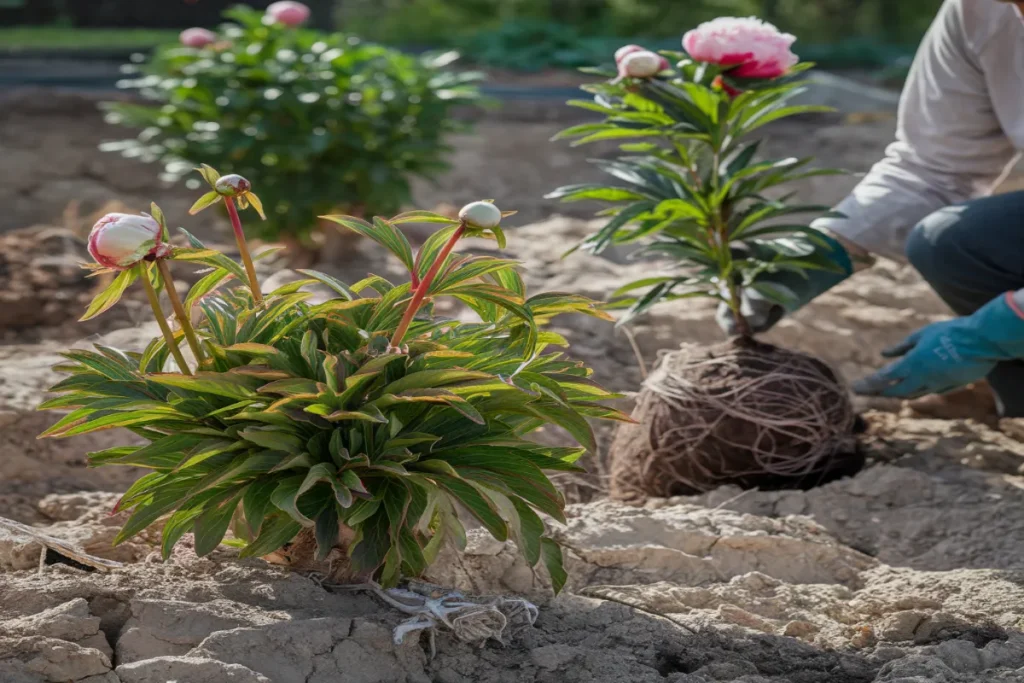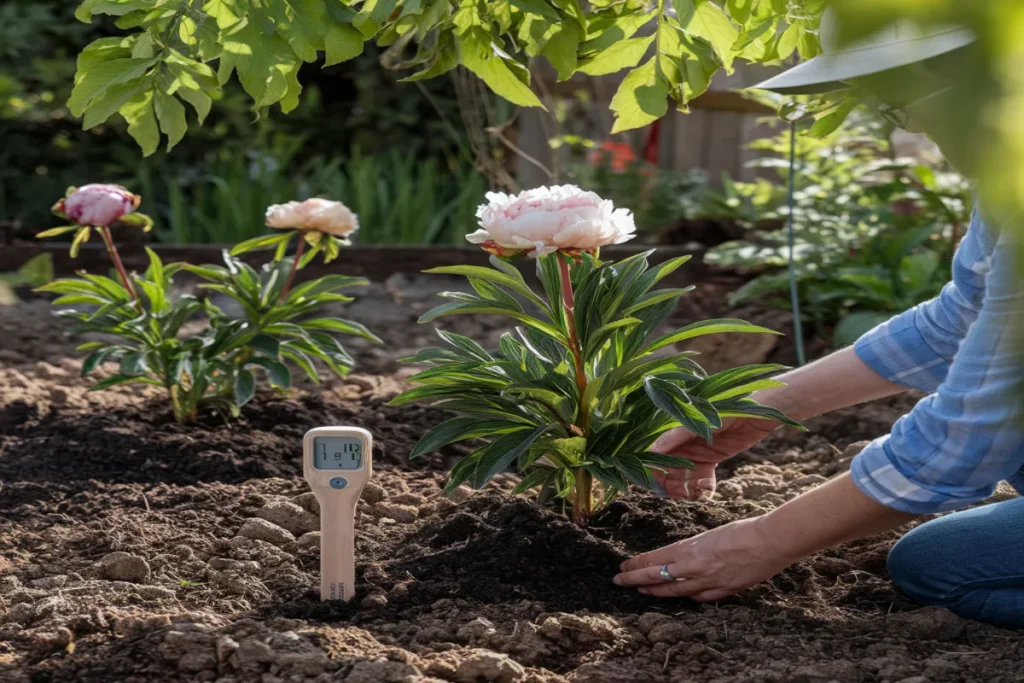In Vermont, Barbara Miller’s garden was home to peonies for over 20 years. Every spring, they bloomed beautifully. But recently, their colors weren’t as bright. Barbara thought it was time to transplant them.
Knowing when to transplant peonies is key for gardeners. These perennials can live for decades and thrive in cold weather. Transplanting at the right time in spring or fall is important for their health and blooms.
Experts say the best time to transplant peonies is during their dormant periods. This is usually in early spring or late fall. This helps the plants grow new roots without stress.
For transplanting peonies, timing is everything. In the North, mid-August is best. In the South, early November works well. Choosing the right time helps your peonies grow strong and bloom well.
Transplanting peonies aims to keep them blooming beautifully. About half will bloom in the first year. By the second year, they will bloom fully. With care and the right techniques, your peonies will bloom magnificently for years.
Table of Contents
Understanding Peony Growth Cycles
Peonies are fascinating perennials with a unique growth pattern. Gardeners should understand this before transplanting peony plants. These flowers have a specific life cycle that affects when transplanting is best.
The Life Cycle of Peonies
The growth cycle of peonies is complex and seasonal. They go through several important stages each year:
- Dormancy in winter months
- Root development in early spring
- Foliage and bud formation
- Blooming period
- Seed production
When Do Peonies Bloom?
Peonies bloom in mid to late spring. Research reveals:
- 50% of newly planted peonies bloom in the first year
- 100% of transplanted peonies bloom by the second year
- By the third year, plants develop multiple stems and form fuller clumps
Importance of Dormancy
Dormancy is key for replanting peonies. During this time, the plant focuses on root development. This is vital for future growth. Peonies typically die back in fall and prepare for the next spring.
| Growth Stage | Key Characteristics |
|---|---|
| Dormancy | Plant conserves energy, root development occurs |
| Early Spring | Root growth, initial foliage emergence |
| Late Spring | Peak blooming period |
Understanding the peony’s growth cycle is key to successful transplantation and long-term plant health.
By recognizing these growth patterns, gardeners can optimize their transplanting strategies. This ensures the best results for their beloved peony plants.
Signs That It’s Time to Transplant Peonies
Gardeners often wonder when to move peony plants. Knowing the right time to transplant peonies can greatly improve their health and blooms. Spotting the key signs ensures your peonies keep thriving.
Lack of Blooming
When peonies stop blooming well, it’s a clear sign they need to be moved. Plants that are too deep or have settled soil can greatly reduce blooms. A peony that once bloomed beautifully but now barely does is asking to be moved.
- Fewer than expected flowers each season
- Weak or stunted flower production
- No blooms for multiple consecutive years
Root Bound Plants
When peonies are too crowded, their health suffers. Look for these signs that your peonies are root-bound:
- Roots visibly circling the planting area
- Reduced growth and vigor
- Competing with neighboring plant roots
Soil Degradation

Poor soil can also mean it’s time to move peonies. Compacted or nutrient-poor soil hinders growth and blooms. Regularly check your soil to see if it’s time to move your peonies.
“A healthy peony needs well-draining, nutrient-rich soil with enough sun,” experts say.
By watching for these signs, gardeners can decide when to move their beloved peonies. This ensures they continue to add beauty and life to your garden.
Best Seasons for Transplanting Peonies
Gardeners often wonder when the best time is to move peonies. The season you choose can greatly affect the plant’s health and how well it blooms. Knowing the best times to move peonies is key to a successful transplant.
Choosing the Right Transplanting Season
Transplanting peonies in fall is the top choice for gardeners. This time has many benefits:
- Plants naturally go dormant
- Roots can grow strong before winter
- The plant faces less stress
Seasonal Considerations for Transplanting
Transplanting peonies in summer is possible but comes with challenges. The heat can harm the plant and mess with its growth. Experts recommend these times:
- Early Fall (September): Best time to transplant peonies
- Late Spring: Possible, but riskier
- Summer: Not advised due to heat stress
Regional Transplanting Factors
Where you live is very important for moving peonies. Different climates need different approaches:
- Cooler areas: Move peonies earlier in fall
- Warmer zones: Wait for cooler temperatures
- Watch local frost dates
*Pro tip: Always check your local climate when transplanting peonies.*
Transplanting peonies needs patience. It can take up to three years for them to bloom fully. Timing and technique are essential for your peonies to thrive.
How to Prepare for Transplanting
Transplanting peonies needs careful planning and attention. Knowing the best time to move a peony is key. It ensures the plant’s health and future blooms.
Essential Tools and Materials
Before transplanting peonies in spring, you’ll need:
- Sharp spade or garden fork
- Gardening gloves
- Organic compost
- Measuring tape
- Pruning shears
Preparing the Optimal Planting Site
Choose a spot that meets peonies’ needs. They do best in:
- Full sun (6-8 hours daily)
- Well-draining soil
- Protection from strong winds
- Enough space between plants
Soil Requirements for Successful Transplanting
Soil is key for peony success. Here’s how to prepare it:
| Soil Characteristic | Recommended Specification |
|---|---|
| pH Level | 6.5-7.0 (slightly acidic to neutral) |
| Organic Matter | 50/50 mix of compost and native soil |
| Drainage | Well-draining, no standing water |
| Planting Depth | Eyes 2 inches below soil surface |
“Proper preparation is the foundation of successful peony transplantation” – Gardening Experts
By following these steps, you can create a perfect spot for your peonies to thrive.
Steps to Successfully Transplant Peonies
Transplanting peonies needs careful planning and precision. Timing and technique are key for the plant’s survival and growth. Knowing the best practices helps gardeners move these beautiful perennials successfully.
Before starting, consider these important factors for transplanting peonies:
- Optimal transplanting seasons: September or early spring
- Avoid transplanting during active growth periods
- Wait until the plant is dormant
Preparing for Transplantation
Experts say the best time to move a peony is late September or early spring. Peonies have a unique root system that’s easy to relocate. They extend only 12 to 18 inches beneath the soil.
Digging Up Peonies
Follow these steps to dig up your peony:
- Dig a wide circle around the plant
- Gently slide a sharp shovel under the root system
- Carefully lift the entire root ball
- Rinse remaining soil to inspect roots
Replanting Techniques
| Transplanting Requirement | Recommended Specification |
|---|---|
| Hole Size | Double width of root system |
| Planting Depth | Crown 1 inch below soil surface |
| Spacing | 3 feet between plants |
Pro Tip: Be patient with transplanted peonies. They may take 2-3 years to reach maximum bloom. They might not flower abundantly in the first year after moving.
Remember, successful peony transplantation is about understanding the plant’s natural growth cycle and providing optimal conditions for root establishment.
Care After Transplanting
Transplanting peonies needs careful post-move care. Gardeners must focus on creating the best conditions for root growth and plant recovery when moving peonies in spring.
Watering Essentials for Newly Transplanted Peonies
Proper hydration is key after transplanting a peony bush. New peonies need steady moisture without being too wet. Here are some watering tips:
- Water deeply once per week
- Provide approximately 1 inch of water
- Use slow, steady watering technique
- Avoid overhead sprinklers
Fertilization Strategies
Nutrient management is vital for fern peony transplant success. Follow these fertilization tips:
| Timing | Fertilizer Type | Application Rate |
|---|---|---|
| Early Spring | Balanced 10-10-10 | 1/2 cup per plant |
| Late Fall | Low-nitrogen organic compost | 1 inch layer around base |
Mulching for Protection
Mulching keeps soil moist and controls temperature. Apply 2-3 inches of organic mulch around the plant, keeping it away from the stem to prevent rot.
“Patience is key when transplanting peonies. Allow 2-3 years for full establishment and optimal blooming.” – Garden Experts
Common Mistakes When Transplanting Peonies
Transplanting peonies needs careful attention. Gardeners often face challenges that can harm the plant’s health and future blooms.
Watering Pitfalls
Many gardeners struggle with watering when digging up peonies. Both overwatering and underwatering can harm transplanted peonies:
- Overwatering causes root rot and fungal diseases
- Underwatering leads to stress and slow growth
- New transplants need steady moisture without being too wet
Soil Quality Challenges
Can you transplant peonies in the fall successfully? It depends a lot on soil preparation. Ignoring soil quality can stop the plant from growing well.
- Soil pH should be between 6.0 and 8.0
- Soil should drain well and have organic matter
- Avoid heavy clay or compacted soils
Pruning and Planting Errors

Wrong pruning and planting depth can hurt peony health. Important things to remember include:
- Plant roots no deeper than 2 inches below the soil surface
- Avoid transplanting during the active growing seasons
- Remove damaged or diseased roots before replanting
“Patience and careful preparation are the keys to successful peony transplantation.”
By knowing these common mistakes, gardeners can make sure their peonies do well after moving. This will create beautiful and healthy garden displays for years.
Frequently Asked Questions
Can peonies be dug up and moved?
Yes! Peonies can be transplanted, but timing is key. The best time to move them is in the fall (September to October) when they are dormant. Dig carefully around the root ball, keeping as much of the root system intact as possible. Replant them quickly, keeping the eyes (buds) 1-2 inches below the soil surface. They may take a year or two to bloom again after being moved.
When can peonies be divided and transplanted?
The best time to divide and transplant peonies is in the fall when the plant is dormant. September to October is ideal, giving the roots time to settle before winter. Avoid dividing in spring or summer, as it can stress the plant and reduce blooms the following season.
Do peonies like to be crowded?
No, peonies do not like to be crowded. They need at least 3 feet of space between plants for good air circulation. Crowded peonies may have fewer blooms and are more prone to disease like powdery mildew. Give them room to thrive!
Do peonies like sun or shade?
Peonies love full sun! They need at least 6 hours of direct sunlight daily for strong blooms. In hotter climates, they can handle a little afternoon shade, but too much shade will lead to weak stems and fewer flowers.
Do peonies multiply on their own?
Not really. Peonies grow larger over time, but they don’t send out runners or spread like some perennials. If you want more peonies, you’ll need to divide them manually by digging up and separating the root clump in the fall.
How do you keep peonies blooming all summer?
Peonies naturally have a short bloom period (about 7-10 days), but you can extend the season by:
Planting early, mid-season, and late-blooming varieties for staggered blooms.
Deadheading spent flowers to keep the plant healthy (but this won’t produce new blooms).
Ensuring full sun and proper care to encourage bigger, better blooms next season.
Pairing with summer-blooming plants like coneflowers or daylilies to keep the garden colorful after peonies fade.

